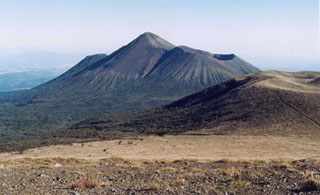Report on Kirishimayama (Japan) — 11 October-17 October 2017
Smithsonian Institution / US Geological Survey
Weekly Volcanic Activity Report, 11 October-17 October 2017
Managing Editor: Sally Sennert.
Please cite this report as:
Global Volcanism Program, 2017. Report on Kirishimayama (Japan) (Sennert, S, ed.). Weekly Volcanic Activity Report, 11 October-17 October 2017. Smithsonian Institution and US Geological Survey.
Kirishimayama
Japan
31.934°N, 130.862°E; summit elev. 1700 m
All times are local (unless otherwise noted)
JMA reported that an eruption at Shinmoedake (Shinmoe peak), a stratovolcano of the Kirishimayama volcano group, began at 0534 on 11 October, prompting the agency to raise the Alert Level to 3 (on a scale of 1-5). Ash plumes rose 300 m above the crater rim (2 km a.s.l.) and drifted NE, though some news sources stated that plumes rose 2 km above the crater rim. Volcanic-tremor amplitude increased and inflation was detected. Ashfall was noted in at least four towns in the Miyazaki and Kagoshima prefectures. On 12 October ash plumes rose as high as 2 km. Based on JMA notices, pilot observations, and satellite data, the Tokyo VAAC reported that ash plumes rose 1.8-2.1 (6,000-7,000 ft) a.s.l. on 11 October and 3.4 km (11,000 ft) a.s.l. on 12 October.
Gas measurements taken during field surveys on 12 and 13 October showed that the sulfur dioxide flux was 1,400 tons/day, an increase from 800 tons/day measured on 11 October. Volcanic tremor fluctuated but the amplitude was slightly lower. During 0823-1420 on 14 October an event produced a tall plume which rose 2.3 km above the crater rim. Another event, at 1505, generated a grayish-white plume that rose 1 km and then blended into the weather clouds. Ashfall was reported in Kirishima and Sono in the Kagoshima prefecture, and from Kobayashi in the Miyazaki prefecture to Hyuga city. An event was detected at 1300 on 15 October, and an increase in low-frequency earthquakes was recorded on 16 October.
Geological Summary. Kirishimayama is a large group of more than 20 Quaternary volcanoes located north of Kagoshima Bay. The late-Pleistocene to Holocene dominantly andesitic group consists of stratovolcanoes, pyroclastic cones, maars, and underlying shield volcanoes located over an area of 20 x 30 km. The larger stratovolcanoes are scattered throughout the field, with the centrally located Karakunidake being the highest. Onamiike and Miike, the two largest maars, are located SW of Karakunidake and at its far eastern end, respectively. Holocene eruptions have been concentrated along an E-W line of vents from Miike to Ohachi, and at Shinmoedake to the NE. Frequent small-to-moderate explosive eruptions have been recorded since the 8th century.
Sources: Japan Meteorological Agency (JMA), Tokyo Volcanic Ash Advisory Center (VAAC), Associated Press

